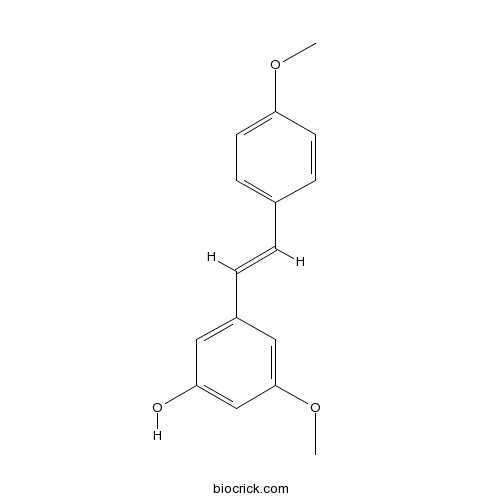3-Hydroxy-4',5-dimethoxystilbeneCAS# 58436-29-6 |

Quality Control & MSDS
3D structure
Package In Stock
Number of papers citing our products

| Cas No. | 58436-29-6 | SDF | Download SDF |
| PubChem ID | 5473051 | Appearance | Powder |
| Formula | C16H16O3 | M.Wt | 256.3 |
| Type of Compound | Phenols | Storage | Desiccate at -20°C |
| Solubility | Soluble in Chloroform,Dichloromethane,Ethyl Acetate,DMSO,Acetone,etc. | ||
| Chemical Name | 3-methoxy-5-[(E)-2-(4-methoxyphenyl)ethenyl]phenol | ||
| SMILES | COC1=CC=C(C=C1)C=CC2=CC(=CC(=C2)OC)O | ||
| Standard InChIKey | ULMJJZHWFJYIMM-ONEGZZNKSA-N | ||
| Standard InChI | InChI=1S/C16H16O3/c1-18-15-7-5-12(6-8-15)3-4-13-9-14(17)11-16(10-13)19-2/h3-11,17H,1-2H3/b4-3+ | ||
| General tips | For obtaining a higher solubility , please warm the tube at 37 ℃ and shake it in the ultrasonic bath for a while.Stock solution can be stored below -20℃ for several months. We recommend that you prepare and use the solution on the same day. However, if the test schedule requires, the stock solutions can be prepared in advance, and the stock solution must be sealed and stored below -20℃. In general, the stock solution can be kept for several months. Before use, we recommend that you leave the vial at room temperature for at least an hour before opening it. |
||
| About Packaging | 1. The packaging of the product may be reversed during transportation, cause the high purity compounds to adhere to the neck or cap of the vial.Take the vail out of its packaging and shake gently until the compounds fall to the bottom of the vial. 2. For liquid products, please centrifuge at 500xg to gather the liquid to the bottom of the vial. 3. Try to avoid loss or contamination during the experiment. |
||
| Shipping Condition | Packaging according to customer requirements(5mg, 10mg, 20mg and more). Ship via FedEx, DHL, UPS, EMS or other couriers with RT, or blue ice upon request. | ||
| Description | Reference standards. | |||||

3-Hydroxy-4',5-dimethoxystilbene Dilution Calculator

3-Hydroxy-4',5-dimethoxystilbene Molarity Calculator
| 1 mg | 5 mg | 10 mg | 20 mg | 25 mg | |
| 1 mM | 3.9017 mL | 19.5084 mL | 39.0168 mL | 78.0336 mL | 97.5419 mL |
| 5 mM | 0.7803 mL | 3.9017 mL | 7.8034 mL | 15.6067 mL | 19.5084 mL |
| 10 mM | 0.3902 mL | 1.9508 mL | 3.9017 mL | 7.8034 mL | 9.7542 mL |
| 50 mM | 0.078 mL | 0.3902 mL | 0.7803 mL | 1.5607 mL | 1.9508 mL |
| 100 mM | 0.039 mL | 0.1951 mL | 0.3902 mL | 0.7803 mL | 0.9754 mL |
| * Note: If you are in the process of experiment, it's necessary to make the dilution ratios of the samples. The dilution data above is only for reference. Normally, it's can get a better solubility within lower of Concentrations. | |||||

Calcutta University

University of Minnesota

University of Maryland School of Medicine

University of Illinois at Chicago

The Ohio State University

University of Zurich

Harvard University

Colorado State University

Auburn University

Yale University

Worcester Polytechnic Institute

Washington State University

Stanford University

University of Leipzig

Universidade da Beira Interior

The Institute of Cancer Research

Heidelberg University

University of Amsterdam

University of Auckland

TsingHua University

The University of Michigan

Miami University

DRURY University

Jilin University

Fudan University

Wuhan University

Sun Yat-sen University

Universite de Paris

Deemed University

Auckland University

The University of Tokyo

Korea University
- Isoeuphorbetin
Catalog No.:BCN8918
CAS No.:50677-55-9
- Licoflavanone
Catalog No.:BCN8917
CAS No.:119240-82-3
- Schisphenin E
Catalog No.:BCN8916
CAS No.:1311376-52-9
- Stevia impurity (13-[(2-O-6-deoxy-β-D-glucopyranosyl-3-O-β-D-glucopyranosyl-β-D-glucopyranosyl)oxy]ent-kaur-16-en-19-oic acid β-D-glucopyranosyl ester)
Catalog No.:BCN8915
CAS No.:1309929-72-3
- Methylgomisin O
Catalog No.:BCN8914
CAS No.:1276654-07-9
- Dichotomine B
Catalog No.:BCN8913
CAS No.:755036-41-0
- 2-Methoxy-5-acetoxy-furanogermacr-1(10)-en-6-one
Catalog No.:BCN8912
CAS No.:1809980-25-3
- Methyl neochebulinate
Catalog No.:BCN8911
CAS No.:1236310-34-1
- Biatractylolide
Catalog No.:BCN8910
CAS No.:182426-37-5
- Arisantetralone B
Catalog No.:BCN8909
CAS No.:1161947-96-1
- Rebaudioside F
Catalog No.:BCN8908
CAS No.:438045-89-7
- Arisanschinin E
Catalog No.:BCN8907
CAS No.:1333378-33-8
- Ginsenoside MC
Catalog No.:BCN8920
CAS No.:175484-06-7
- (1E)-3-methoxy-8,12-epoxygermacra-1,7,10,11-tetraen-6-one
Catalog No.:BCN8921
CAS No.:1393342-06-7
- 5-Hydroxy-7,8-dimethoxy (2R)-flavanone-5-O-beta-D-glucopyranoside
Catalog No.:BCN8922
CAS No.:942626-74-6
- (3S,5S,E)-1,7-Diphenylhept-1-ene-3,5-diol
Catalog No.:BCN8923
CAS No.:87095-75-8
- (3R,5S,E)-1,7-Diphenylhept-1-ene-3,5-diol
Catalog No.:BCN8924
CAS No.:232261-31-3
- Nardoaristolone B
Catalog No.:BCN8925
CAS No.:1422517-82-5
- 19-O-beta-D-carboxyglucopyranosyl-12-O-beta-D-glucopyranosyl-11,16-dihydroxyabieta-8,11,13-triene
Catalog No.:BCN8926
CAS No.:1011714-20-7
- Erucifolin N-oxide
Catalog No.:BCN8928
CAS No.:123864-94-8
- Heliotridine
Catalog No.:BCN8929
CAS No.:520-63-8
- Integerrimine N-oxide
Catalog No.:BCN8930
CAS No.:85955-28-8
- Intermedine N-oxide
Catalog No.:BCN8931
CAS No.:95462-14-9
- Jacobine N-oxide
Catalog No.:BCN8932
CAS No.:38710-25-7
Antimicrobial activity of resveratrol-derived monomers and dimers against foodborne pathogens.[Pubmed:31862939]
Sci Rep. 2019 Dec 20;9(1):19525.
Plant polyphenolic compounds are considered a promising source for new antibacterial agents. In this study, we evaluated the antimicrobial activity of a collection of resveratrol-derived monomers and dimers screened as single molecules against a panel of nine foodborne pathogens. The results demonstrated that two monomers (i.e., pterostilbene 2 and (E)-3-hydroxy-4',5-dimethoxystilbene 9) and three dimers (i.e., delta-viniferin 10, viniferifuran 14 and dehydro-delta-viniferin 15) were endowed with significant antibacterial activity against gram-positive bacteria. The exposure of gram-positive foodborne pathogens to 100 microg/mL of 2, 9 and 15 induced severe cell membrane damage, resulting in the disruption of the phospholipid bilayer. The most promising dimeric compound, dehydro-delta-viniferin 15, was tested against Listeria monocytogenes, resulting in a loss of cultivability, viability and cell membrane potential. TEM analysis revealed grave morphological modifications on the cell membrane and leakage of intracellular content, confirming that the cell membrane was the principal biological target of the tested derivative.


